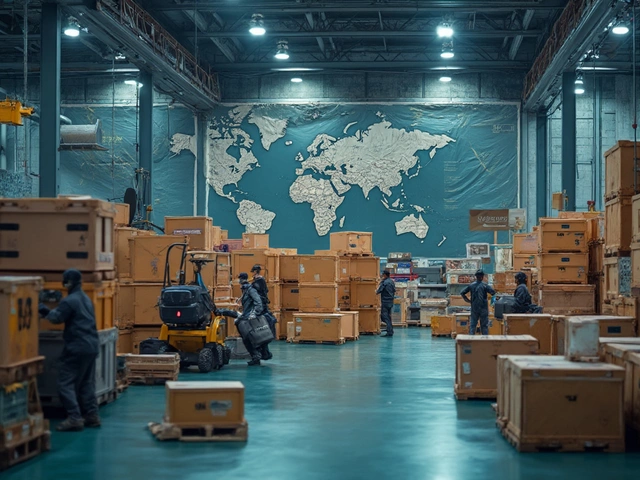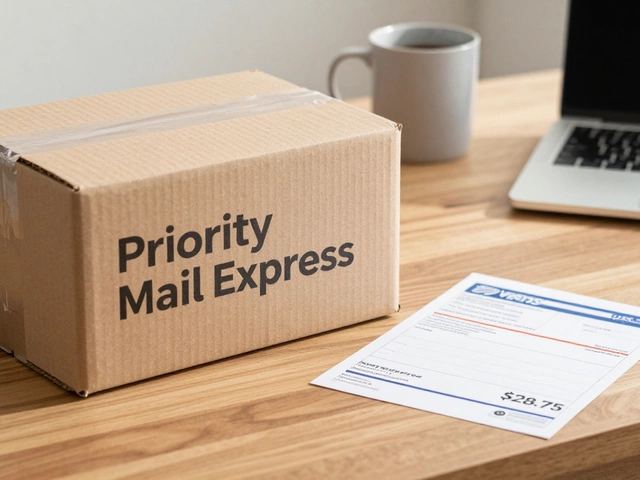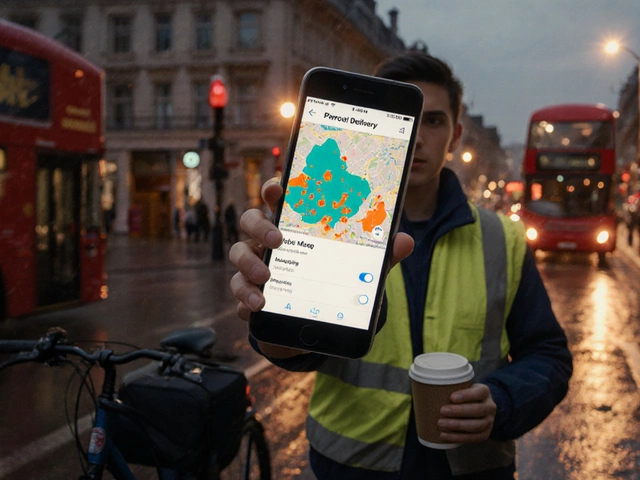Ever wonder how that phone case or kitchen gadget makes its way to your door so fast after you order online? It’s not magic—it’s all logistics, and for e-commerce, there are three must-have activities that keep everything running. If just one slips, orders get delayed, customers get cranky, and businesses lose money.
First, a quick heads up: logistics isn’t just for the big players like Amazon. Even small online stores rely on sharp logistics to stay alive. The main activities, and honestly the stars of the show, are inventory management, order fulfillment, and transportation. Get these right and you’re already ahead of a bunch of competitors. Get them wrong, and you’ll see frustrated customers and a pileup of returns.
If you’re looking to cut costs, speed things up, or just keep your shop running smoothly, understanding these main activities is your ticket. No matter your size, these logistics basics set the foundation for e-commerce success.
- The Backbone: Inventory Management
- Picking, Packing, and Fulfillment
- Transportation and Last Mile Delivery
- How Technology Has Changed the Game
- Common Challenges (and How to Beat Them)
- Quick Tips for Smoother Logistics
The Backbone: Inventory Management
Inventory management is what keeps e-commerce logistics running like a well-oiled machine. If you can’t keep track of what’s in stock, chaos is just around the corner. It’s simple: no solid inventory control, no business growth. A report from the Aberdeen Group found that companies with real-time inventory tracking have a 97% order fulfillment rate. That’s no fluke—it’s what happens when you treat your stock like gold.
For small shops, inventory might mean a spare bedroom filled with products. For bigger players, it's thousands of products across multiple warehouses. Either way, the same rules apply.
- Know exactly what’s in stock—missing or miscounted products lead to dreaded “out of stock” notices that can kill sales.
- Update inventory in real time. Selling on multiple channels (website, Amazon, eBay)? One glitch or delay in your system and you'll oversell, leading to refunds or upset customers.
- Pare down dead stock. Holding on to slow-moving products just eats up space and cash. Use reports to know what’s just sitting there.
Most pros use inventory management software now. There are plenty of options like Shopify, Zoho, or even bigger-scope stuff like NetSuite. These tools help automate stock updates, forecast demand, and cut down on mistakes.
Check out this breakdown from a leading retail analytics firm on average stock accuracy by business size:
| Business Size | Manual System Accuracy | Software-Based Accuracy |
|---|---|---|
| Small (1-10 employees) | 80% | 94% |
| Medium (11-100 employees) | 85% | 97% |
| Large (100+ employees) | 88% | 99% |
Here’s a tip: Perform a quick count every month if you’re small, or use barcode scanners for quick checks if you’re scaling up. Fix mistakes right away. Otherwise, a small error today can turn into a week of headaches later.
This first leg of e-commerce logistics sets the pace for everything that follows. Get your inventory in order and you’re miles ahead already.
Picking, Packing, and Fulfillment
After someone clicks “buy,” the order heads into the heart of logistics—fulfillment. This step is where the action kicks in with picking, packing, and getting orders ready to ship out. Done right, you keep customers happy. Mess it up, and you’ll see returns, complaints, or even bad reviews piling up.
Picking is all about finding the correct items in your warehouse or storage space. Fast and accurate picking is non-negotiable—Amazon figured this out early, using robots and scanners to help workers grab the right products. A study from Ware2Go shows that picking errors are one of the top reasons for e-commerce returns, costing companies up to $35 per order.
Once the items are picked, packing rolls in. Sounds simple, right? But this is where a lot of mistakes sneak in—items get damaged or the wrong size box gets used. Packing isn't just about bubble wrap; it’s matching boxes to products, adding shipment labels, and often including return slips or branded inserts. If you want to speed things up, set up packing stations with everything staff needs in one spot.
"Speed and accuracy matter in e-commerce fulfillment more than almost anywhere else. One mispick can wreck a customer’s trust." — Steve Banker, ARC Advisory Group
The last leg is actual fulfillment—moving orders from packed and ready to shipped-out status. For smaller shops, this often means printing labels and calling a courier. For bigger players, there are automated conveyors and partnerships with fulfillment centers.
Here’s a quick rundown of the main steps most fulfillment operations use:
- Order comes in and is checked in the system.
- Picking slip is generated—shows warehouse staff what to grab.
- Staff (or robots) locate and pick each item.
- Packing station: items are checked, packed, and sealed.
- Shipping label slapped on, tracking emailed to customer.
Speed and error reduction really matter in e-commerce logistics. Amazon claims its same-day shipping is possible because they can pick and pack an order in under 30 minutes. For smaller stores, batch picking (grabbing multiple orders in one lap) can save time, while double-checking each order cuts down on errors.
| Metric | Average |
|---|---|
| Pick Accuracy | 98.5% |
| Packed Orders per Hour | 65 |
| Average Fulfillment Time (Order to Ship) | 2.1 hours |
If you want real control, invest in a good warehouse management system (WMS). Even a simple smartphone app can track orders, cut out manual errors, and keep your team in the loop.
Transportation and Last Mile Delivery
After an order is picked and packed, it still needs to move from the warehouse to the customer’s doorstep. This is the part a lot of people underestimate—transportation eats up a big chunk of costs and creates most delivery headaches. In e-commerce, you can’t afford to ignore how products flow from point A to point B (and sometimes even back—hello, returns).
The trip starts with bulk shipping. Carriers like FedEx, UPS, DHL, and tons of regional couriers handle everything from pallets of electronics to a single pair of shoes. Big e-commerce stores spread their warehouses across the country for a reason: the closer inventory is to customers, the faster and cheaper shipping gets. Amazon Prime’s same-day delivery in major cities works only because Amazon has fulfillment centers sprinkled everywhere.
Now, "last mile delivery" is where things get wild. This covers the final part, from the local facility to your doorstep. It’s the most expensive and complex leg because it deals with a zillion addresses, traffic, and customer quirks. Studies show last mile delivery can eat up to 53% of total shipping costs. For e-commerce, cracking the last mile puzzle decides whether you can offer cheap or fast shipping that keeps customers coming back.
Companies use all sorts of hacks to manage this. Some use gig drivers (like Uber or DoorDash), some try out lockers for customer pickups, and others even turn to drones or autonomous vehicles for short hops. Local partnerships with bike couriers in busy cities shave hours off delivery times, making a huge difference for urgent orders.
Want to keep shipping costs down? Here are a few practical tips:
- Use multiple delivery partners, not just one. This lets you compare rates and avoid delays from overbooked carriers.
- Try local micro-warehouses or fulfillment hubs if you sell high-volume products in specific regions.
- Offer customers choices, like standard vs. rush shipping, and let them pick up from lockers if they want.
Whether you’re a small online shop or aiming to scale up, nailing the e-commerce logistics game really comes down to getting transportation and last mile delivery right. Whoever solves these faster and cheaper usually wins over the most loyal customers.

How Technology Has Changed the Game
Not that long ago, e-commerce logistics meant spreadsheets, guesswork, and a phone glued to your ear. These days, technology runs the show, and it’s not just big shops benefiting. Even garage startups get access to tools that were out of reach a decade ago.
The rise of real-time inventory systems is one of the biggest game changers. With RFID tags, barcodes, and cloud-based platforms, businesses can track products instantly—they know exactly what’s on the shelf, what’s moving, and what’s stuck. This means way fewer mistakes and faster updates for both the business and the customer.
Automation is another huge win. Robots pick and pack orders in massive fulfillment centers, and smart conveyor belts move items to the right spot—no wandering around a warehouse. Amazon warehouses use over 750,000 robots, and they credit tech with cutting processing times by more than half.
Let’s not forget route optimization tools. Shipping companies, whether it’s FedEx or a local courier, use AI to find the quickest delivery routes—adjusting for weather, traffic, and even fuel prices. This is what makes ‘same-day delivery’ possible in so many cities.
Curious how much these updates help? Here’s a quick breakdown:
| Technology | Impact |
|---|---|
| RFID & Barcode Tracking | 70% drop in inventory errors |
| Warehouse Automation | Up to 50% reduction in labor costs |
| Route Optimization Software | Up to 25% faster delivery times |
There’s also just way more transparency now. Customers get automatic order updates, with live tracking on their phone. That builds trust—especially important if you’re running a new e-commerce store.
- If you’re new to e-commerce, start with a good inventory management system. Even free versions beat spreadsheets.
- Look for shipping partners that use route optimization. Faster delivery means happier buyers.
- Automation doesn’t always mean robots—it could be automated packing labels or smart stock alerts. Small changes add up.
In short, tech doesn’t just make things faster—it helps businesses avoid errors, save cash, and keep customers coming back for more. If you want your e-commerce logistics setup to compete, plugging into the right tech tools is non-negotiable.
Common Challenges (and How to Beat Them)
Even big e-commerce names hit roadblocks in logistics. Sometimes it’s as simple as running out of top-selling products, or as wild as packages getting stuck in customs for days. If you run an online store, expect some headaches—but there are smart ways to deal with the biggest issues.
Inventory issues are probably public enemy number one. Stores often find themselves either swamped with slow-moving products or suddenly sold out of bestsellers. Missing that balance can freeze your cash flow and disappoint customers. Top e-commerce brands fight this problem by using real-time tracking and data analytics to decide when to restock or discount items. Don’t rely on guesses—use software that actually reflects sales and stock numbers as they happen.
Poor order fulfillment leads to wrong or late deliveries. This usually comes from a disorganized picking or packing process in the warehouse. Short on workers? Orders will lag. Too many human errors? Returns will stack up. Some companies now use scanners or even robots to find and pack items faster and more accurately. And a simple trick: double-check addresses and use clear labels on every package.
Shipping problems come next. Things like high costs, delayed couriers, and that dreaded last mile—when the parcel moves from a local hub to your customer’s front step. If you’re not careful, shipping can eat away profits. One fix is to offer multiple shipping options so customers can pick what they want: speed, price, or eco-friendly delivery. Negotiate bulk rates with carriers if you have volume. For smaller businesses, using a shipping aggregator can help snag better rates and track parcels all the way to the door.
Here’s a quick-hit cheat sheet for dealing with the most common headaches in e-commerce logistics:
- Use automated inventory tools—ditch the paper spreadsheets, they just can’t keep up.
- Regularly train packing staff and keep your space organized.
- Get clear on your carrier’s cutoff times and stick to them.
- Send tracking details to customers every time. The less guessing, the better.
- Keep a close eye on returns data to spot problem products fast.
Every shop will hit bumps in the road, but staying alert and flexible makes all the difference. Keep learning from mistakes, stay up on tech, and always be ready to tweak your process.
Quick Tips for Smoother Logistics
Stuck with slow orders or messy stockrooms? Here’s where you can turn things around without going overboard on budget or time. These moves actually work for any shop, not just heavy hitters.
- Automate what you can. Software tools take over boring stuff like updating inventory and printing shipping labels. Shopify, ShipStation, and TradeGecko each shave hours off manual work. A 2024 survey showed businesses automated at least one logistics task saw errors drop by 40%.
- Batch your shipping. Group orders by location or shipping speed. It’s easier for pickers (and cheaper with some couriers), instead of doing them one-by-one.
- Track packages from start to finish. This isn’t just about customer peace of mind—logistics dashboards let you spot hold-ups before shoppers complain. UPS says real-time tracking can reduce delivery-related calls by up to 70%.
- Keep your inventory management system updated, always. ‘Phantom inventory’ (stuff you think you have but don’t) is the easiest way to tank your ratings. Regular counts and software alerts cut down screw-ups.
- Negotiate with multiple couriers. Don’t settle for one shipping company. Prices and speed change fast, especially on holidays. Rotate carriers or mix express and economy for better deals.
Here’s how some of these tips usually pay off:
| Tip | Potential Benefit |
|---|---|
| Automation | Cut error rates by 40%, speed up order processing |
| Batch Shipping | Up to 30% lower fulfillment costs for grouped shipments |
| Real-Time Tracking | Fewer support queries, faster resolution of missed deliveries |
| Accurate Inventory | Reduce out-of-stock complaints, boost customer reviews |
| Courier Flexibility | Save 10-25% on shipping, especially during peak season |
Small upgrades in these areas go a long way, especially as your orders grow. The trick is to start with what matters most—usually better tracking and keeping your inventory numbers honest. Nail those, and the rest falls into place a lot faster.





